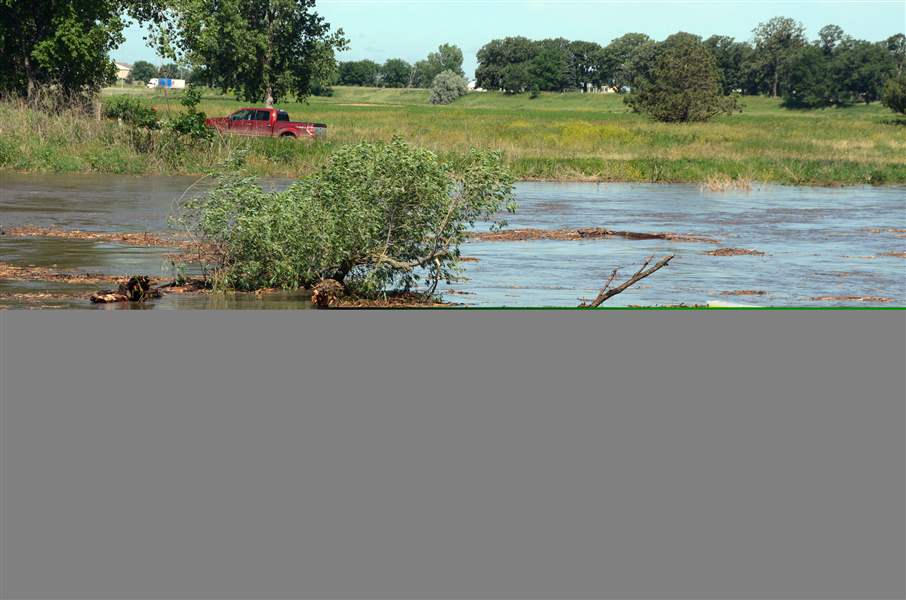
Cities fight Big Sioux River flooding in 3 states
6/19/2014
A large tree branch speeds down a fast-moving Big Sioux River.
ASSOCIATED PRESS

A large tree branch speeds down a fast-moving Big Sioux River.
SIOUX CITY, Iowa — Record Big Sioux River flooding prompted residents in three states to hurriedly prepare for the rising water today, with people lining up for sandbags and moving museum artifacts and other items to higher ground.
The fast-moving Big Sioux has been swollen by days of thunderstorms and is expected to crest Friday more than a foot above the previous record level set in 1969, threatening homes and businesses in Iowa, Nebraska and South Dakota.
In North Sioux City, South Dakota, dozens of National Guard soldiers were rushing to fill sandbags for residents of the McCook Lake neighborhood, where up to 400 homes were in danger of flooding.
Residents including Ashley Caskey waited for hours in a line of pickup trucks that inched toward the sandbag-filling stations.
“We are just happy to get sandbags at this point,” Caskey said.
Tim Webster, who lives in an upstairs apartment on McCook Lake, said he wasn’t worried about his place but was helping friends.
“Anybody who knows me knows I’ve got a truck, so let’s do this,” he said.
This is the worst flooding the region has seen since 2011, when the Missouri River remained high for months, causing tributaries to back up and testing the levee system. The fact that the levee held for long at that time showed it’s effective, said Jade Dundas, assistant city manager for public works for Sioux City, Iowa.
This time, the Big Sioux should begin receding Saturday and stop flooding even nearby agricultural land by Monday morning.
“This kind of a quick up and down does give us some sense of confidence,” Dundas said.
The city had to extend one of its levees by about 600 feet and that work is finished. Sioux City crews helped property owners fill sandbags as a precautionary measure, he said.
At The Railroad Museum near the river in Sioux City, volunteers helped staff move artifacts to higher ground because the main building will likely get about 5 feet of water, said museum executive director Matt Merk. Vintage rolling stock including a 1943 General Electric diesel locomotive was among exhibits moved to safety, Merk said.
“At the very worst at this point we’ll have cleanup and nothing completely damaged except for some sheet rock,” he said.
Crews were building a temporary levee that will run across Interstate 29. It should protect much of North Sioux City but will close off a few miles of the interstate and force motorists onto local roads between Sioux City, Iowa, and Sioux Falls, South Dakota, to the north.
The river level is expected to peak at about 4 feet below the levee height, said Nathan Sanderson, a policy adviser to South Dakota Gov. Dennis Daugaard. He said the interstate will be closed for at least 36 hours but that it’s difficult to predict how much longer after that.
Floodwaters blocked most of the roads connecting South Dakota and Iowa between Sioux Falls and Sioux City.
Dennis and Dottie Oleson’s house in Akron, Iowa, sits on high ground so they haven’t had to deal with flooding. A levee breached early Wednesday in the town, causing flooding in a business district, but a temporary patch is holding.
“The water was a lot higher yesterday,” Dennis Oleson said.
He and his wife drove about 6 miles south of the town to see how the floodwaters overtook the Iowa State Highway 3 crossing into South Dakota. The heavy rains created a giant lake far wider than the Big Sioux just to the east, and several tiny fish were trying to wiggle their way across the two-lane road against the flow.
Dakota Dunes, South Dakota, a community between the Big Sioux and Missouri rivers is potentially vulnerable. The existing levee has been raised and city officials said they’re confident it will hold the Big Sioux back, but they have an evacuation plan.
Jefferson, South Dakota, about 7 miles north of North Sioux City, hired a local contractor to build a 3-foot-high berm around the northeast side of the town of nearly 550 to hold back the Big Sioux.
“If we get it, it would probably be just part of town,” Police Chief Bill McKelvey said. “We’re hoping the dike will keep it out altogether.”